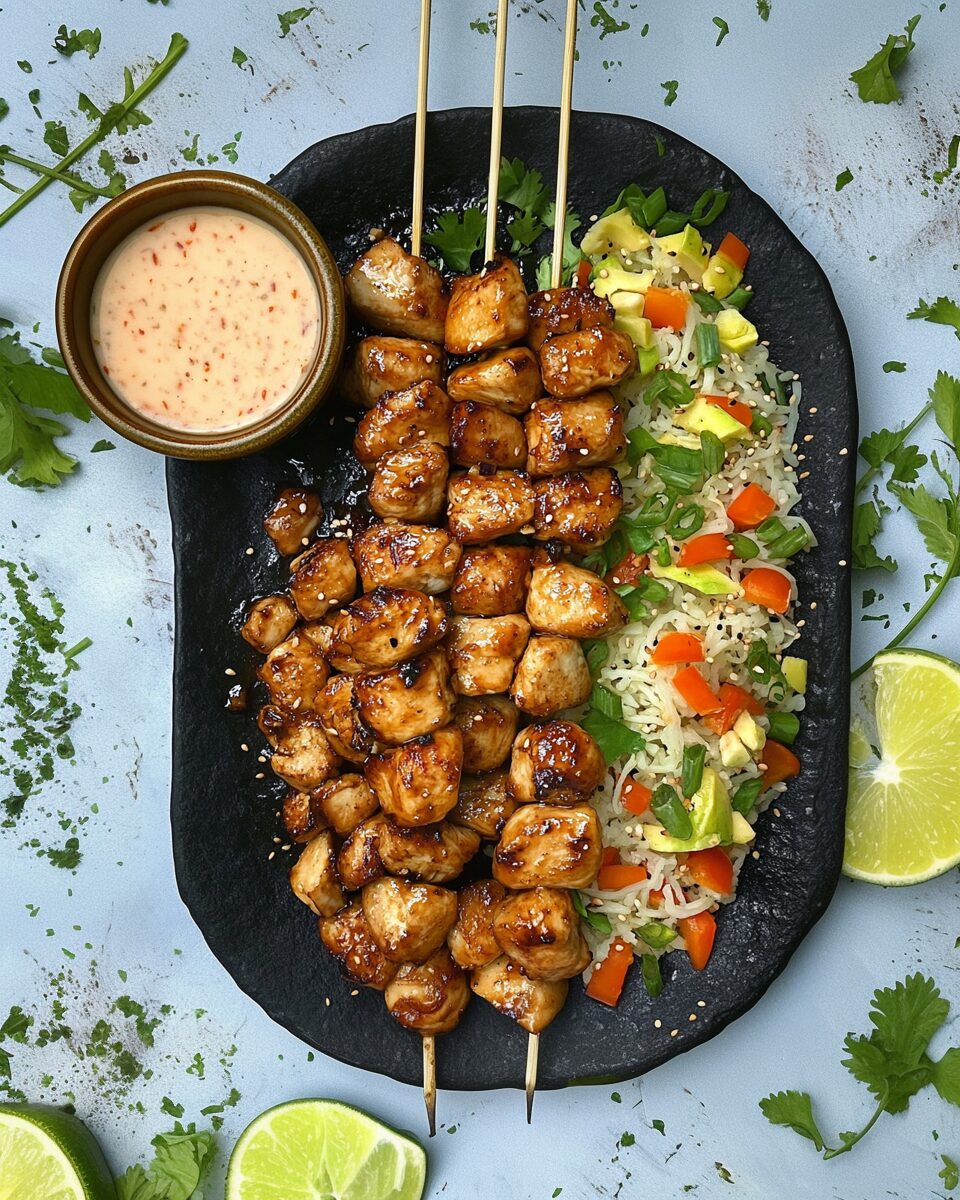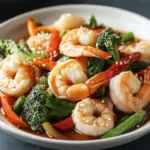This Hibachi Chicken recipe brings the delicious flavors of a Japanese steakhouse right into your own kitchen! Juicy chicken pieces are cooked with a buttery soy glaze, paired perfectly with fried rice and sautéed vegetables. Perfect for an easy, flavorful dinner that feels special without a lot of fuss.
Full Recipe:
Ingredients
- 1½ pounds boneless skinless chicken thighs or breasts, cut into bite-sized pieces
- 2 tablespoons soy sauce
- 1 tablespoon sesame oil
- 1 tablespoon butter
- 1 tablespoon minced garlic
- 1 tablespoon chopped ginger
- 1 tablespoon olive oil
- Salt and pepper, to taste
- Optional garnish: chopped scallions and sesame seeds
Directions
- In a bowl, mix the chicken pieces with 1 tablespoon of soy sauce and sesame oil. Set aside to marinate for 15 minutes.
- Heat olive oil in a large skillet or griddle over medium-high heat.
- Add the marinated chicken pieces and sauté for about 5–6 minutes until they start to brown.
- Push the chicken to one side of the skillet. On the empty side, melt the butter and add minced garlic and chopped ginger. Cook for about a minute until fragrant.
- Stir everything together and pour in the remaining 1 tablespoon of soy sauce. Cook for another 2–3 minutes until the chicken is cooked through.
- Season with salt and pepper to taste.
- Garnish with chopped scallions and sesame seeds, if desired. Serve hot with fried rice and sautéed veggies!
Nutrients
(Estimated per serving based on 4 servings)
- Calories: 280 kcal
- Protein: 25g
- Fat: 18g
- Saturated Fat: 5g
- Carbohydrates: 3g
- Fiber: 0.5g
- Sugar: 0g
- Sodium: 600mg
- Cholesterol: 110mg
The Origins of Hibachi Cooking
The hibachi method of cooking has deep roots in Japanese culinary tradition. The word “hibachi” translates to “fire bowl,” a small portable grill that uses charcoal as its heat source. In Japan, hibachi grills have been used for centuries, traditionally for heating and cooking food over direct flame. They were once primarily used for cooking meat, fish, and vegetables, allowing the natural flavors to shine.
However, when most people refer to “hibachi” today, especially in Western countries, they are typically referring to a cooking style commonly seen at Japanese steakhouses. Hibachi grills are large, flat cooking surfaces where food is prepared right in front of the diners, a style of cooking often associated with “teppanyaki” cooking. Though the term hibachi has been loosely used to describe these meals, the actual cooking method involves grilling or pan-frying food in large amounts of oil, which helps to lock in flavor while creating a crispy exterior.
Why Hibachi Chicken Is So Popular
There are several reasons why Hibachi Chicken has gained so much popularity, particularly in the United States. First and foremost, the dish offers a wonderful balance of flavors. The chicken is tender and flavorful, thanks to the soy sauce and sesame oil marinade, while the garlic and ginger add an aromatic punch. The slight sweetness of the soy sauce and the nutty undertones from the sesame oil make it an unforgettable meal.
Another reason for its popularity is the convenience and speed at which it can be prepared. Unlike other more intricate Japanese dishes, Hibachi Chicken doesn’t require a long list of exotic ingredients or complicated cooking techniques. Whether you are a seasoned chef or a home cook looking to try something new, Hibachi Chicken is easy to prepare and sure to impress. It’s the perfect option for those who enjoy cooking meals that are both simple and flavorful.
Additionally, the hibachi cooking style is fun and interactive. Cooking the chicken on a flat top grill or in a large skillet allows the chef to entertain and engage with guests, making the meal more enjoyable. The sizzling sound, the aromatic smells, and the vibrant presentation all contribute to an overall delightful dining experience.
What Makes Hibachi Chicken Different from Other Chicken Dishes?
Hibachi Chicken stands apart from other types of chicken dishes due to its unique cooking method and flavor profile. The key difference is in the marinade and cooking process. Unlike other chicken dishes that may rely on deep frying or baking, Hibachi Chicken uses a quick sauté or grill method, ensuring that the chicken remains tender and juicy while developing a slightly crispy exterior.
The marinade is also a distinctive feature of Hibachi Chicken. While most chicken recipes use basic ingredients like salt, pepper, and herbs, Hibachi Chicken is marinated in soy sauce, sesame oil, garlic, and ginger. This combination of ingredients infuses the chicken with rich umami flavors while enhancing its natural juices. The sesame oil gives the dish a distinctive nutty flavor, and the ginger adds an aromatic zing that’s often missing in traditional chicken recipes.
The technique of grilling or sautéing also sets Hibachi Chicken apart. By cooking the chicken at high temperatures, it achieves a seared exterior while maintaining a moist and tender interior. This quick, high-heat cooking method locks in the flavors and ensures the chicken retains its natural juiciness.
The Role of Hibachi Chicken in Japanese Cuisine
Hibachi Chicken, while widely popular in the United States, has roots deeply embedded in Japanese culinary culture. As mentioned, hibachi cooking originated with small portable grills that allowed for outdoor cooking over charcoal. In Japan, meals were often prepared on these grills in communal settings, where family and friends would gather around the grill and enjoy the process of cooking together.
In Japanese cuisine, the concept of “umami” is central, which refers to the savory, rich flavor that comes from ingredients like soy sauce, miso, and seafood. Hibachi Chicken incorporates this umami flavor, making it a perfect example of the Japanese culinary focus on balanced and harmonious tastes. The combination of savory soy sauce, nutty sesame oil, and the aromatic heat of garlic and ginger is quintessentially Japanese and reflects the delicate balance of flavors found in traditional Japanese dishes.
In the West, however, hibachi cooking has been adapted to suit the tastes of the local population. Hibachi Chicken, as served in many hibachi restaurants, is often paired with fried rice, grilled vegetables, and sometimes even sauces like teriyaki or garlic butter. These adaptations make the dish more accessible and familiar to Western palates while still maintaining the core principles of Japanese hibachi cooking.
Hibachi Chicken Variations
While the classic Hibachi Chicken recipe is a favorite among many, there are numerous variations you can try to personalize the dish to your preferences. One common variation is the inclusion of vegetables like bell peppers, zucchini, mushrooms, or onions. These vegetables can be sautéed alongside the chicken, adding extra flavor and texture to the meal.
For those who prefer a bit of heat, adding chili peppers or red pepper flakes to the marinade can provide an extra kick. A drizzle of spicy mayo or a dash of hot sauce after cooking can also enhance the dish’s flavor profile, adding depth and spice.
For a slightly sweeter version, you can incorporate honey or brown sugar into the marinade. This will balance out the saltiness of the soy sauce and provide a subtle sweetness to complement the savory chicken.
If you’re looking for a healthier alternative, you can substitute boneless skinless chicken breasts for thighs, or opt for a lower-sodium soy sauce to reduce the overall salt content.
Nutritional Benefits of Hibachi Chicken
Hibachi Chicken offers several nutritional benefits. The dish is a great source of lean protein, especially when using skinless chicken breast or thigh meat. Chicken is rich in essential amino acids, which are necessary for muscle repair, immune function, and overall body maintenance.
In addition to protein, Hibachi Chicken also provides a variety of vitamins and minerals. The garlic and ginger in the marinade contain antioxidants and anti-inflammatory properties, which may contribute to better digestion and overall health. Sesame oil is also a heart-healthy fat, and the vegetables often included in hibachi meals are rich in fiber, vitamins, and minerals.
Conclusion
In conclusion, Hibachi Chicken is a flavorful, easy-to-make dish that brings the vibrant and savory tastes of Japanese cooking into your home. Whether you’re cooking for a family dinner, a special occasion, or just looking to try something new, Hibachi Chicken is sure to impress. The combination of juicy chicken, rich marinades, and high-heat cooking creates a dish that’s both delicious and satisfying.






